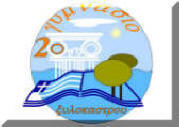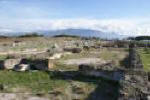

PECULIAR POINTS OF OUR AREA - KORINTHIA
Diolkos-Isthmus of Corinth
Diolkos was a stone-paved
road that indented the edges of the Isthmus. It’s width was 3,5-5 meters. In the
middle of the road there were two deep parallel furrows which abstained 1,5
meters. 
 On these furrows were being
moved the wheels of an extremely big, in ength, device which was carrying the
oat band was transporting it from the one edge of Isthmus to the other and by
this way, boats wouldn’t mhs by cureating a channel. But he was murdered and the
work ceased.ake the round of Peloponnese. It was built inm the era of Periander.
Neron, in the67 AD tried to open Isthmus
by creating a channel. But he was murdered and the work ceased.
On these furrows were being
moved the wheels of an extremely big, in ength, device which was carrying the
oat band was transporting it from the one edge of Isthmus to the other and by
this way, boats wouldn’t mhs by cureating a channel. But he was murdered and the
work ceased.ake the round of Peloponnese. It was built inm the era of Periander.
Neron, in the67 AD tried to open Isthmus
by creating a channel. But he was murdered and the work ceased.

The work was repeated by
the French architect Lesseps in 1881 and was completed
 in
1893.Since then,thre is the “canal of Corinth” with the length of 6 kilometers,
width of 25 meters above and 21 meters bellow,8 meters depth and wall height
over 75 meters.
in
1893.Since then,thre is the “canal of Corinth” with the length of 6 kilometers,
width of 25 meters above and 21 meters bellow,8 meters depth and wall height
over 75 meters.
Lechaion port

From ancient times Corinthians needed a port in the Gulf of Corinth. Before the port was constructed there was a mire over this area. Ancient Corinthians materialized excavations and dredging and increased the strip of the land towards the open sea, to be useful as a breakwater. In the 4th century BC the port was very important. In the 4th century AC moles, vertical to the line of the beach. This project had been taken in charge of a proconsul of Achaia,
the Flavios Ermogenis.
Today is a big port at the beach of the modern town of Corinth. In place of the ancient port of Lechaio there is now a lagoon. The harbor was unable to continue its operation because beach was sandy and its maintenance difficult.
Heraion of Perachora(ancient port)
 On the west of
Loutraki there is a peninsula, Perachora From the 8th century BC
Corinthians were been established there. At the end of the peninsula there was a
small bay that was used as the ancient port. There, there was a temple of Hera
with extremely important offerings of the geometric archaic periods. In 400 BC
it had been built a porch that served people, as a market.
On the west of
Loutraki there is a peninsula, Perachora From the 8th century BC
Corinthians were been established there. At the end of the peninsula there was a
small bay that was used as the ancient port. There, there was a temple of Hera
with extremely important offerings of the geometric archaic periods. In 400 BC
it had been built a porch that served people, as a market.
There was a water reservoir which is maintained until today. That was the place where, according to the legend, Medea killed her children. It was a great religious center in ancient times. With the advent of Christianity, it was, there, built a temple of Ioannis Prodromos, so as, the place, to keep it’s sanctity until
 today. The
beauty of the landscape makes the area a popular destination for many nature
lovers.
today. The
beauty of the landscape makes the area a popular destination for many nature
lovers.
PELLINI
 Ancient Pellini was
between the rivers Kryos and Sythas in terms of mountain Cyllene. It was
inhabited from the second millennium BC. It was there where Achaeans arrived
chased by the Dorians after the descent of the Dorians to Peloponnese. They
founded a great city which in classical times had, approximately, 30000
inhabitants. In the city there was a temple dedicated to goddess Athena with
gold statue which was made by Pheidias, famous sculptor of antiquity. There was
a grove dedicated to the goddess Artemis. Also, there were temples and shrines
of Dionysus and Apollo. At the market there was a large tank of water and a gym.
After the Hellenistic period the city declined and was gradually abandoned by
it’s inhabitants.
Ancient Pellini was
between the rivers Kryos and Sythas in terms of mountain Cyllene. It was
inhabited from the second millennium BC. It was there where Achaeans arrived
chased by the Dorians after the descent of the Dorians to Peloponnese. They
founded a great city which in classical times had, approximately, 30000
inhabitants. In the city there was a temple dedicated to goddess Athena with
gold statue which was made by Pheidias, famous sculptor of antiquity. There was
a grove dedicated to the goddess Artemis. Also, there were temples and shrines
of Dionysus and Apollo. At the market there was a large tank of water and a gym.
After the Hellenistic period the city declined and was gradually abandoned by
it’s inhabitants.

Today near the archaeological site there is the village Zougra. From the ancient city there is almost nothing saved.
Stymphalos

 Stymphalos
was an ancient city built near the village Kiona,on the southern foot of Mount
Kyllini. It was on the north shore of the lake Stymphalia where, accordingto
the legend, Heracles realized one of the feats by killingthe stymphalian hens.
Stymphalos
was an ancient city built near the village Kiona,on the southern foot of Mount
Kyllini. It was on the north shore of the lake Stymphalia where, accordingto
the legend, Heracles realized one of the feats by killingthe stymphalian hens.
The area was inhabited from the Neolithic period, but it became successful in the 4th century. It was arranged in regular rectangular grid (Ippodameio system) with a width of 36 m. It was surrounded by wall length 2.5 km. There were towers along the wall it had several gates. Amaxilatos route is a unique work on the rock leading to the acropolis.
Today the most visible and impressive monument in Stymphalos are the ruins a Franconian church in the north of the city. This church constructed with materials from the excellent ancient temple of Artemis.
Sources: www.korinthia.net/arxaia